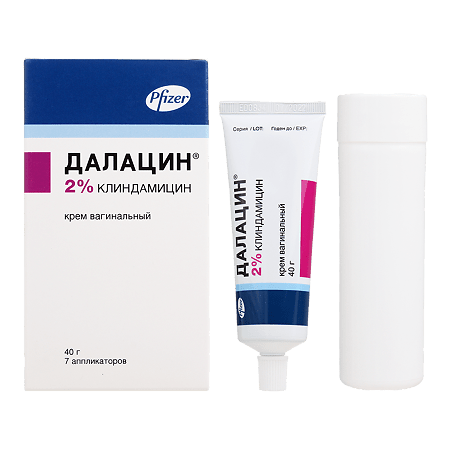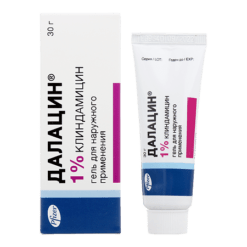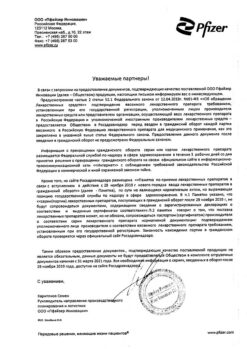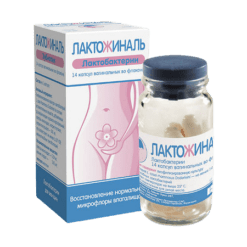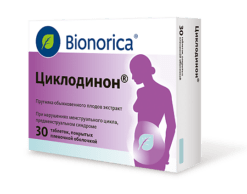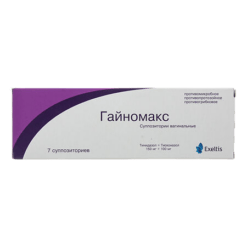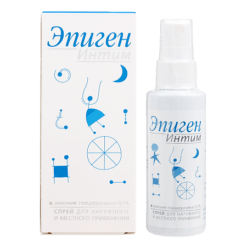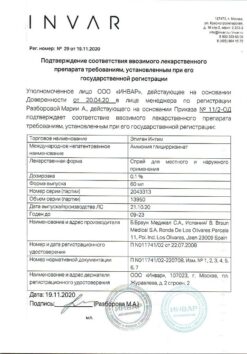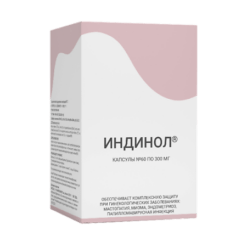No products in the cart.
Dalacin, vaginal cream 2% 40 g
€28.22 €23.52
Description
Pharmacotherapeutic group: antibiotic – lincosamide.
ATX code: G01AA10.
Pharmacological properties
Pharmacodynamics
Clindamycin phosphate is inactive in vitro but is rapidly hydrolyzed in vivo to form clindamycin, which has antibacterial activity. Clindamycin belongs to the group of antibiotics-linkosamides, which inhibits protein synthesis in the microbial cell through interaction with the 50S ribosome subunit and affects the translation process.
Clindamycin, like most protein synthesis inhibitors, is primarily a bacteriostatic whose effectiveness is related to the duration of maintenance of the concentration of the active substance at a higher level than the MAC (Minimum Inhibitory Concentration) of the infecting organism.
Resistance to clindamycin is in most cases due to modification of ribosomal target sites usually through chemical modification of RNA nitrogen bases or point mutations of RNA or sometimes protein mutations. Under in vitro conditions, cross-resistance between lincosamides, macrolides, and Streptogramine B has been demonstrated in some organisms. There is a cross-resistance between clindamycin and lincomycin.Under in vitro conditions, the following microorganisms causing bacterial vaginosis are sensitive to clindamycin: Gardnerella vaginalis, Mobiluncus spp., Mycoplasma hominis, Bacteroides spp., Peptostreptococcus spp.Bacterial culture and sensitivity studies are not usually performed to establish the diagnosis and guide treatment for bacterial vaginosis. There is no standard methodology for evaluating the sensitivity of potential bacterial vaginosis pathogens (Gardnerella vaginalis, Mobiluncus spp.) Methods for determining the sensitivity of Bacteroides spp and Gram-positive anaerobic cocci, also Mycoplasma spp. described by the Clinical and Laboratory Standards Institute (CLSI), and borderline sensitivity values for clindamycin for Gram-negative and Gram-positive anaerobic bacteria are published by the European Committee on Antimicrobial Susceptibility Testing (EUCAST). For clinical isolates that are sensitive to clindamycin but resistant to erythromycin, clindamycin resistance should also be tested using the D-test. However, borderline values are intended to guide systemic antibiotic treatment rather than local treatment.
Pharmacokinetics
. After administration of clindamycin intravaginally at a dose of 100 mg/day once (as 2% clindamycin phosphate cream) for 7 days, serum concentrations peak about 10 h (4-24 h) after administration and average 18 ng/mL (4-47 ng/mL) on day one and 25 ng/mL (6-61 ng/mL) on day 7, with systemic absorption of about 4% (0.6-11%) of the administered dose.
In women with bacterial vaginosis, about 4% of clindamycin is absorbed with a similar dosing regimen (with a smaller variation of 2-8%), with serum concentrations peaking about 14 h (4-24 h) after administration and averaging 13 ng/mL (6-34 ng/mL) on day 1 and 16 ng/mL (7-26 ng/mL) on day 7.
The systemic effects of clindamycin when administered intravaginally are weaker than when administered orally or intravenously. After intravaginal administration of repeated doses, clindamycin almost does not accumulate in the blood. The systemic half-life is 1.5-2.6 h.
Application in older patients
In clinical trials of clindamycin 2% vaginal cream, not enough patients 65 years of age or older have participated to be able to evaluate the difference in clinical response to therapy between this age group and younger patients. In the available reports from clinical experience, there was no difference in response between older patients and younger patients.
Indications
Indications
Bacterial vaginosis.
Pharmacological effect
Pharmacological effect
Pharmacotherapeutic group: antibiotic – lincosamide.
ATX code: G01AA10.
PHARMACOLOGICAL PROPERTIES
Pharmacodynamics
Clindamycin phosphate is inactive in vitro, but is rapidly hydrolyzed in vivo to form clindamycin, which has antibacterial activity. Clindamycin belongs to the group of lincosamide antibiotics, which inhibits protein synthesis in microbial cells through interaction with the 50S ribosomal subunit and affects the translation process.
Clindamycin, like most protein synthesis inhibitors, is primarily a bacteriostatic, the effectiveness of which is associated with the duration of maintaining the concentration of the active substance at a level higher than the MIC (Minimum Inhibitory Concentration) of the infecting organism.
Resistance to clindamycin in most cases occurs due to modification of ribosomal target sites, usually through chemical modification of RNA nitrogenous bases or point mutations in RNA or sometimes protein mutations. In vitro, some organisms have demonstrated cross-resistance between lincosamides, macrolides and streptogramin B. There is cross-resistance between clindamycin and lincomycin. In in vitro conditions, the following microorganisms that cause bacterial vaginosis are sensitive to clindamycin: Gardnerella vaginalis, Mobiluncus spp., Mycoplasma hominis, Bacteroides spp., Peptostreptococcus spp. Bacterial culture and sensitivity studies are not routinely performed to establish the diagnosis and guide treatment of bacterial vaginosis. There is no standard methodology for assessing the susceptibility of potential bacterial vaginosis pathogens (Gardnerella vaginalis, Mobiluncus spp.). Methods for determining the sensitivity of Bacteroides spp and gram-positive anaerobic cocci, also Mycoplasma spp. are described by the Clinical and Laboratory Standards Institute (CLSI), and clindamycin susceptibility breakpoints for gram-negative and gram-positive anaerobic bacteria are published by the European Committee on Antimicrobial Susceptibility Testing (EUCAST). For clinical isolates that are tested to be susceptible to clindamycin but resistant to erythromycin, testing should also be performed to determine clindamycin resistance using the D test. However, breakpoints are intended to guide systemic antibiotic treatment rather than topical treatment.
Pharmacokinetics
After using intravaginal clindamycin at a dose of 100 mg/day once (in the form of 2% clindamycin phosphate cream) for 7 days, the serum concentration reaches a maximum approximately 10 hours (4-24 hours) after administration and averages 18 ng/ml (4-47 ng/ml) on the first day, and 25 ng/ml (6-61) on the seventh day ng/ml), while systemic absorption is about 4% (0.6-11%) of the administered dose.
In women with bacterial vaginosis, with a similar dosing regimen, about 4% of clindamycin is absorbed (with a smaller range of 2-8%), the serum concentration reaches a maximum approximately 14 hours (4-24 hours) after administration and averages 13 ng/ml (6-34 ng/ml) on the first day, and 16 ng/ml (7-26 ng/ml) on the seventh day.
The systemic effect of clindamycin when administered intravaginally is weaker than when administered orally or intravenously. After intravaginal administration of repeated doses, clindamycin almost does not accumulate in the blood. The systemic half-life is 1.5-2.6 hours.
Use in elderly patients
Clinical studies of clindamycin 2% vaginal cream did not include enough patients aged 65 years or older to evaluate the difference in clinical response to therapy between this age group and younger patients. Available reports from clinical experience have shown no difference in response between older and younger patients.
Special instructions
Special instructions
Before prescribing the drug, Trichomonas vaginalis, Chlamydia trachomatis, Neisseria gonorrhoeae, Candida albicans and Herpes simplex virus, which often cause vulvovaginitis, should be excluded using appropriate laboratory methods.
Intravaginal use of clindamycin may lead to increased growth of nonsusceptible microorganisms, especially yeast-like fungi.
The use of clindamycin (like almost all antibiotics) orally or parenterally is associated with the development of severe diarrhea and, in some cases, pseudomembranous colitis. If severe or prolonged diarrhea develops, the drug should be discontinued and, if necessary, appropriate diagnostic and therapeutic measures should be taken.
Patients should be warned that during drug therapy they should not engage in sexual intercourse, or use other means for intravaginal administration (tampons, douching).
The use of DALACIN cream during menstruation is not recommended. The initiation of therapy should be delayed until after menstruation.
The drug contains components that can reduce the strength of latex or rubber products, therefore the use of condoms, vaginal contraceptive diaphragms and other latex products for intravaginal use during drug therapy and within 72 hours after use is not recommended.
Effect on the ability to drive a car and operate machinery
There is no reason to believe that the use of DALACIN vaginal cream can affect the ability to drive a car and operate machinery.
Active ingredient
Active ingredient
Clindamycin
Composition
Composition
Active ingredient: clindamycin phosphate 23.76 mg (in the form of clindamycin 20.0 mg);
Excipients: sorbitan monostearate 20.0 mg, polysorbate 60 50.0 mg, propylene glycol 50.0 mg, stearic acid 21.4 mg, cetostearyl alcohol 32.1 mg, cetyl palmitate 32.1 mg, mineral oil 64.2 mg, benzyl alcohol 10.0 mg, purified water q.s.
Pregnancy
Pregnancy
There have been no adequate controlled studies on the use of the drug in the first trimester of pregnancy, therefore DALACIN vaginal cream can be prescribed to women in the first trimester of pregnancy only for absolute indications, i.e. when the potential benefit of drug therapy for the mother outweighs the potential risk to the fetus.
In animal studies, no adverse effects on the fetus were found when clindamycin was administered subcutaneously or orally, except when the drug was taken in doses toxic to the mother.
When clindamycin was used intravaginally in the second or third trimester of pregnancy, no increase in the incidence of congenital anomalies of the fetus was observed. Abnormal births occurred in 1.1% of women compared with 0.5% in the placebo group when DALACIN vaginal cream was used in the second trimester for 7 days. The use of the drug in the II-III trimester of pregnancy is possible if the potential benefit to the mother outweighs the risk to the fetus.
It is unknown whether clindamycin is excreted into breast milk after intravaginal use. Clindamycin was found in breast milk at a concentration of ˂0.5 – 3.8 μg/ml after systemic use.
Clindamycin has the potential to cause adverse effects on the gastrointestinal flora of breastfed infants, such as diarrhea or blood in the stool, or rash. If a nursing mother requires oral or intravenous clindamycin, this is not a reason to stop breastfeeding, but an alternative drug may be preferred. The developmental and health benefits of breastfeeding should be considered, as well as the clinical need for clindamycin in the mother and any potential adverse effects related to clindamycin or the underlying maternal condition in the breastfed infant.
Contraindications
Contraindications
– hypersensitivity to clindamycin, lincomycin or any component of the drug;
– in patients with a history of antibiotic-associated colitis.
– age under 18 years (data on safety and effectiveness are not available).
Side Effects
Side Effects
The safety of clindamycin vaginal cream was assessed in both non-pregnant patients and in patients during the second and third trimesters of pregnancy.
Table of adverse drug reactions
System-organ class
Very
often
≥ 1/10
Often
From ≥ 1/100 to < 1/10
Uncommon
From ≥ 1/1000 to < 1/100
Rarely
From ≥ 1/10,000 to
< 1/1000
Very
Rarely
< 1/10,000
Frequency unknown
(impossible to estimate
based on available data)
Infectious and parasitic diseases
Fungal infections, infections caused by fungi of the genus Candida
Bacterial infections
Skin candidiasis
Immune system disorders
Hypersensitivity
Endocrine system disorders
Hyperthyroidism
Nervous system disorders
Headache, dizziness, dysgeusia
Disorders of the hearing and vestibular apparatus
Vertigo
Respiratory, thoracic and mediastinal disorders
Upper respiratory tract infections
Nosebleed
Gastrointestinal disorders
Abdominal pain, constipation, diarrhea, nausea, vomiting
Bloating, flatulence, bad breath
Pseudomembranous colitis*, gastrointestinal disorders, dyspepsia
Skin and subcutaneous tissue disorders
Itchy skin, rash
Urticaria, erythema
Maculopapular rash
Musculoskeletal and connective tissue disorders
Back pain
Renal and urinary tract disorders
Urinary tract infections, glycosuria, proteinuria
Dysuria
Pregnancy, postpartum and perinatal conditions
Abnormal birth
Disorders of the genital organs and breast
Vulvovaginal candidiasis
Vulvovaginalitis, vulvovaginal disorders, menstrual irregularities, vulvovaginal pain, metrorrhagia, vaginal discharge
Trichomonas vulvovaginitis, vaginal infections, pelvic pain
Endometriosis
General disorders and reactions at the injection site
Inflammation, pain
Data from laboratory and instrumental studies
Deviation of microbiological test results from the norm
* adverse drug reactions identified in the post-registration period.
Interaction
Interaction
There is cross-resistance between clindamycin and lincomycin. .
It has been established that clindamycin, when used systemically, disrupts neuromuscular transmission and, therefore, can enhance the effect of peripherally acting muscle relaxants, so the drug should be used with caution in patients receiving drugs of this group.
Combined use with other drugs for intravaginal administration is not recommended.
Overdose
Overdose
With intravaginal use of DALACIN cream, absorption of clindamycin is possible in quantities sufficient to cause systemic reactions.
Accidental ingestion of the drug into the gastrointestinal tract can also cause systemic effects similar to those that occur after oral administration of clindamycin in therapeutic doses. Possible systemic side effects include diarrhea, hemorrhagic diarrhea, including pseudomembranous colitis (see sections “Side effects” and “Special instructions”).
Treatment: symptomatic and supportive.
Storage conditions
Storage conditions
At a temperature not higher than 25 oC. Do not freeze!
Keep out of the reach of children!
Shelf life
Shelf life
2 years.
Do not use after the expiration date indicated on the package!
Manufacturer
Manufacturer
Pharmacy and Upjohn Company LLC, USA
Additional information
| Shelf life | 2 years. Do not use after the expiration date on the package! |
|---|---|
| Conditions of storage | At a temperature not exceeding 25 oC. Do not freeze! Keep out of reach of children! |
| Manufacturer | Pfizer, Puerto Rico |
| Medication form | vaginal cream |
| Brand | Pfizer |
Other forms…
Related products
Gynecology and Obstetrics
Buy Dalacin, vaginal cream 2% 40 g with delivery to USA, UK, Europe and over 120 other countries.

